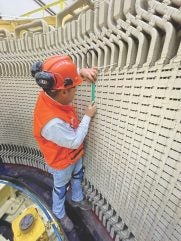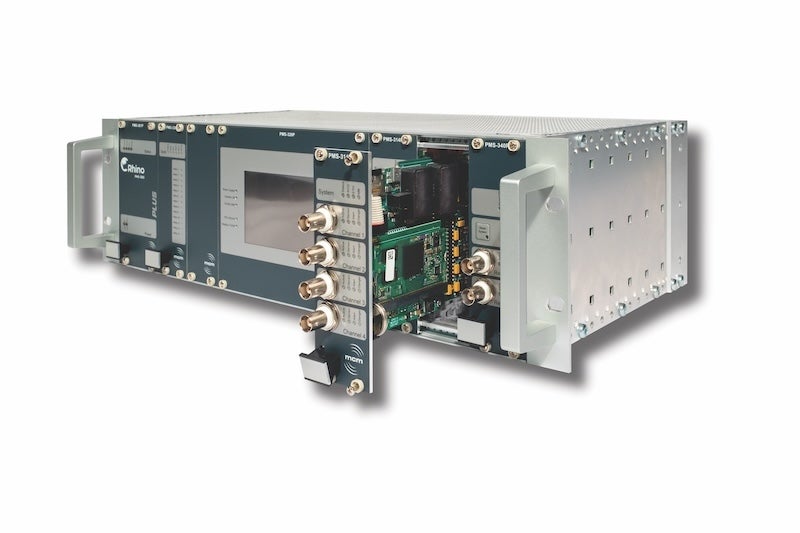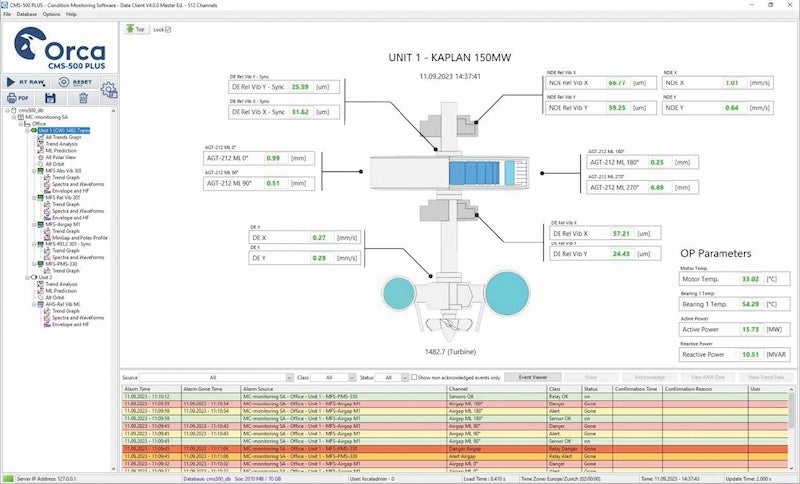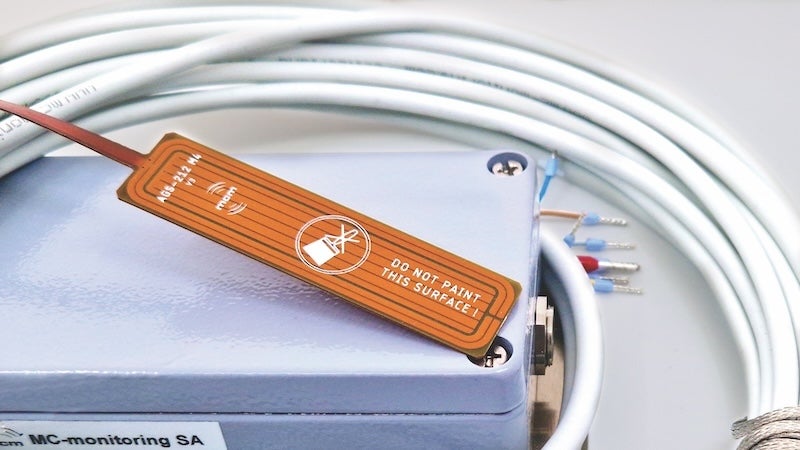
MC-monitoring’s extensive portfolio includes advanced sensor technology, data acquisition units, and condition monitoring software, which collectively provide hydropower operators with early detection capabilities to preemptively identify and address potential issues. Salvatore Adamo, Managing Director of MC-Monitoring, emphasizes the importance of this integrated approach: “Our goal is to deliver comprehensive systems that preemptively catch problems, preventing costly downtime and maximizing efficiency.” By leveraging these advanced tools, hydropower plants can ensure reliability and optimize their operational output.
Enhancing reliability and efficiency
A standout aspect of MC-Monitoring’s technology is its air gap monitoring system. This system continuously measures the rotor-stator distance, a critical factor in ensuring optimal performance. Adamo explains that accurate air gap data is essential for detecting rotor misalignments, mechanical deformations, or eccentricities. “This level of insight allows for proactive maintenance, transforming traditional maintenance strategies from reactive to predictive,” he notes. By addressing potential issues early, the system not only enhances reliability but also contributes to improved overall efficiency by minimizing unplanned downtime.
MC-Monitoring has also introduced groundbreaking innovations in air gap measurement. Utilizing non-contact sensors and high-frequency sampling, the company has achieved a level of accuracy that was previously unattainable. These advancements reduce susceptibility to environmental disturbances, ensuring reliable data. “By making air gap monitoring more precise and less prone to interference, we provide consistent and trustworthy information for operators,” Adamo points out.
Integrated sensors, data acquisition units and software
Integrated sensors, data acquisition units, and software solutions lie at the heart of MC-monitoring’s comprehensive approach. High-precision sensors, designed for durability and accuracy, capture high-resolution data on critical parameters. These data are processed and transmitted by robust acquisition units such as the PMS-300P, enabling a comprehensive, real-time view of equipment health. This seamless integration extends to MC-Monitoring’s CMS-500P condition monitoring software, which provides operators with powerful analytics and actionable insights. Adamo emphasizes that the technology is ‘designed to deliver reliable and resilient performance, even under the harshest conditions, ensuring that operators can make informed decisions with confidence.’


Tackling the challenges of aging infrastructure
One of the biggest hurdles for hydropower operators is managing aging hydrogenerators. These older machines often suffer from insulation degradation, mechanical wear, and rotor eccentricity. MC-Monitoring has developed solutions that are both robust and adaptable to address these issues. From durable sensors that maintain accuracy despite extreme conditions to predictive analytics that identify trends in equipment wear, MC-Monitoring’s technology enables operators to plan maintenance activities more effectively. “We give plant operators the tools to prioritize maintenance and extend the life of their assets,” Adamo states.
Adapting to the demand for flexible hydropower
As the energy landscape evolves, hydropower plants are increasingly expected to operate flexibly, handling frequent load changes and start-stop cycles. To meet this demand, MC-Monitoring has refined its technology to process data rapidly and adapt to operational variability. The systems now employ adaptive algorithms that maintain precise monitoring under shifting conditions. “Our monitoring systems are optimized for flexibility, ensuring reliability and precision even during the most variable operations,” says Adamo.
Compact solutions for condition monitoring
The confined spaces within hydrogenerators pose another significant challenge. In response, MC-Monitoring has developed compact, high-performance sensors that require minimal space. These sensors, such as the AGT (Air Gap Transducers), are engineered to deliver advanced monitoring capabilities without necessitating extensive structural modifications. Adamo highlights, “Our designs focus on miniaturization and modularity, ensuring that even the most space-constrained environments can benefit from our technology.”

Emerging trends in condition monitoring
The future of hydropower monitoring is shaped by trends like the rise of digital twins, increased IoT integration, and AI-driven analytics. MC-Monitoring is at the cutting edge of these innovations, incorporating advanced data analysis tools that enable predictive maintenance. Adamo is optimistic about these advancements: “Digital twins and AI will fundamentally change how we approach condition monitoring, making it more about forecasting and optimization than reaction.” The company is actively developing solutions to harness these trends, enhancing the predictive and analytical capabilities of their systems.
Exploring new applications
MC-Monitoring’s adaptable technology is expanding beyond traditional hydropower plants. New markets, including pumped storage facilities, offshore tidal energy systems, and small-scale hydropower projects, are increasingly adopting MC-Monitoring’s solutions. This expansion demonstrates the versatility of the technology in supporting a diverse range of renewable energy systems. “We see tremendous potential in applying our monitoring expertise to these emerging markets,” says Adamo.
Incorporating digital twins and AI
Digital twin technology represents one of MC-Monitoring’s most significant advancements. By creating virtual models of hydrogenerators, plant operators can simulate real-time conditions and test various operational strategies. These simulations provide valuable insights into equipment behavior, helping to optimize maintenance planning. Adamo believes that “digital twins offer a proactive approach to machine health management, improving decision-making and efficiency.”
Artificial intelligence and machine learning are revolutionizing hydrogenerator monitoring by enhancing predictive capabilities and fault detection. MC-Monitoring leverages these technologies to analyze complex data sets, recognize patterns, and provide actionable insights. “Our AI-driven analytics continuously improve monitoring strategies and ensure that our solutions are always a step ahead,” says Adamo.
Upgrading condition monitoring
For hydropower operators considering system upgrades, MC-Monitoring recommends a strategic approach. Begin with a comprehensive assessment of current monitoring infrastructure and prioritize upgrades for the most critical components. Opt for modular, scalable solutions that can adapt to future technological advances. Adamo advises, “Investing wisely in modular and adaptable systems is key to future-proofing your operations.”
MC-Monitoring’s systems are designed to integrate seamlessly with existing plant control frameworks, such as SCADA and distributed control systems (DCS). This compatibility ensures a centralized view of machine health and simplifies data management, making it easier for operators to implement condition-based maintenance. “Our solutions are built for seamless integration, complementing rather than complicating existing systems,” explains Adamo.
Conclusion
MC-Monitoring’s commitment to driving innovation in hydropower condition monitoring is clear. By combining advanced sensor technology, real-time data acquisition, and AI-based analytics, the company is setting new standards for reliability, efficiency, and foresight in the industry. As hydropower continues to evolve, MC-Monitoring is well-positioned to meet the challenges of today and seize the opportunities of tomorrow.
Real-world impact: condition monitoring case studies in action
Detection of rotor pole loosening in vertical hydrogenerators
In a vertical hydrogenerator, loosening of the rotor poles is a critical issue that can result in imbalance, excessive vibrations, and even potential mechanical failure, particularly under heavy operational loads. To address this, MC-Monitoring implemented a sophisticated solution comprising a combination of vibration sensors and air gap monitoring around the rotor poles. The system continuously tracked vibration patterns and was able to detect early signs of loosening in specific rotor poles. This proactive approach allowed plant operators to schedule a maintenance shutdown in a controlled manner, during which they tightened and reinforced the affected poles. By catching the issue early, the plant avoided significant damage and sidestepped the high costs associated with emergency repairs and extended downtime.
Real-Time Monitoring of Shaft Alignment in Large Generators
Large hydrogenerators are prone to misalignment issues between the rotor shaft and stator, which can lead to increased vibration, wear, and potential damage to critical components such as bearings and the rotor itself. To mitigate this risk, MC-Monitoring deployed advanced real-time shaft alignment sensors coupled with vibration analysis to monitor alignment deviations. These sensors provided continuous, high-precision data on the axial and radial positions of the shaft. The monitoring system alerted operators as soon as alignment moved beyond acceptable thresholds, enabling quick, minor adjustments. This preemptive action helped extend the lifespan of the bearings, minimize mechanical wear, and optimize the generator’s overall efficiency, avoiding more substantial repairs and operational disruptions.
Detection of Vibrational Anomalies in Kaplan Turbine Blades
Kaplan turbines, with their complex adjustable blades, are susceptible to vibrational issues that can compromise blade integrity and lead to inefficient operations or catastrophic failures if not detected in time. MC-Monitoring tackled this challenge by installing vibration sensors directly on the turbine blades. The sensors, in conjunction with advanced data analytics, identified unusual vibrational patterns indicative of wear or structural anomalies. On one occasion, the sensors detected abnormal vibrations on a specific blade, prompting an inspection that revealed early-stage cracks. Thanks to the early warning, plant operators were able to repair the blade before the damage worsened, preventing a costly blade replacement and avoiding significant downtime. Additionally, the monitoring system was instrumental in identifying temperature hotspots during high-load periods, allowing for timely cooling system adjustments and improved ventilation. This intervention minimized the risk of insulation damage and reduced the likelihood of thermal-related failures.
Remote Monitoring of Generator Pole Temperatures Using RTM-200 Contactless Sensors
Monitoring the temperature of rotor poles in a hydrogenerator presents unique challenges due to restricted access and the high demands of continuous operation. High temperatures in these areas can lead to insulation breakdown, demagnetization, or severe electrical faults, making precise monitoring essential. MC-Monitoring addressed this by deploying the RTM-200 contactless temperature sensor, specifically optimized for rotor monitoring in hydrogenerators and motors. The RTM-200 features a 4mm probe that fits into ventilation holes, delivering accurate, linear temperature readings with advanced filtering and signal processing. The sensor connects seamlessly with the MCm Sensor Manager software, enabling real-time temperature and diagnostic monitoring. Its adjustable depth accommodates a wide range of stator cores, allowing for both temporary and permanent installations, with easy removal for maintenance. The implementation of the RTM-200 system allowed operators to continuously monitor rotor pole temperatures, detecting early-stage heating problems that signaled insulation wear or cooling imbalances. By facilitating timely adjustments to the cooling system, this solution helped prevent overheating and contributed to extending the operational life of the generator.






